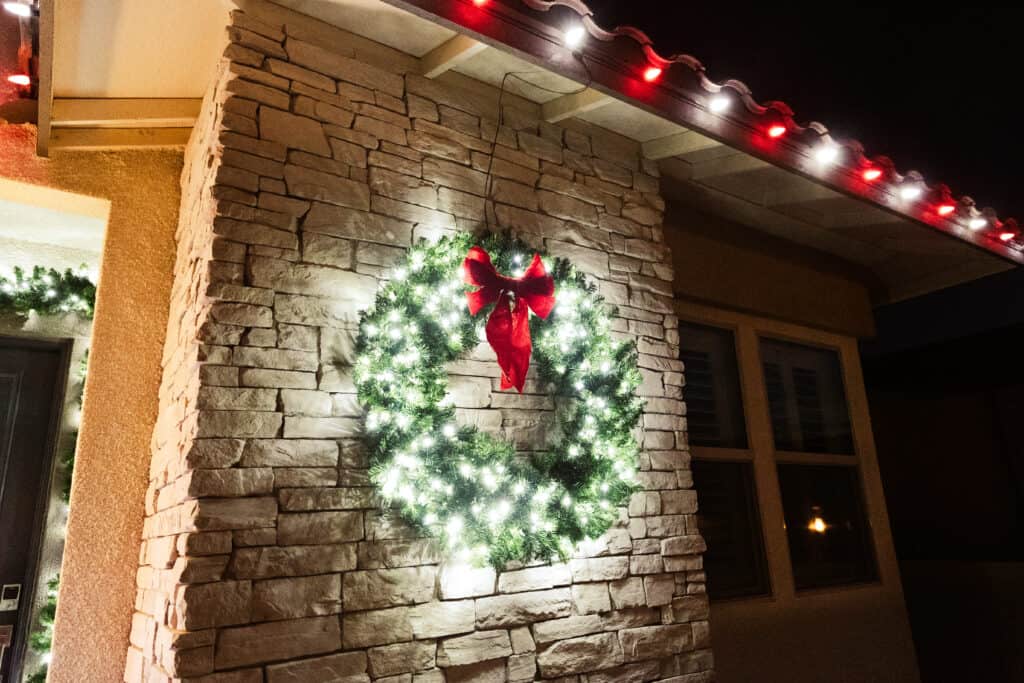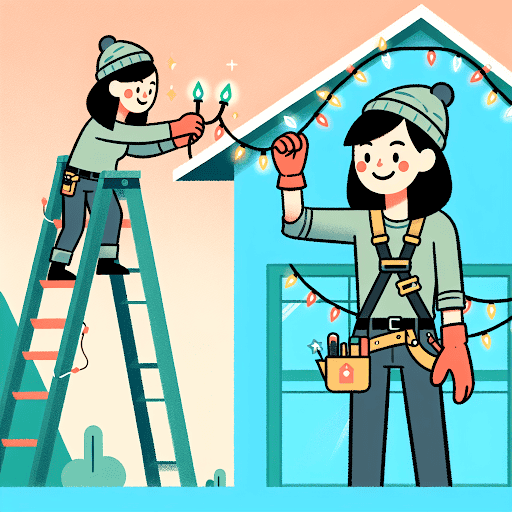The holiday season brings joy and festivity, and nothing captures the magic quite like twinkling Christmas lights adorning homes and landscapes. However, hanging Christmas lights involves various risks that many homeowners overlook in their enthusiasm to create a dazzling display. At Lights Up, we understand the importance of Christmas light safety. This comprehensive guide will walk you through how to safely install Christmas lights, provide detailed instructions for locating electrical panels and checking outlets, and highlight potential dangers that might make you consider hiring professional help.
Table of Contents
Understanding the Risks of DIY Christmas Light Installation

Common Injuries and Accidents
Improper installation of Christmas lights can lead to serious injuries or property damage. Common hazards include:
- Falls from ladders and roofs: Attempting to hang lights at height without proper precautions is a leading cause of holiday injuries.
- Electric shocks: Faulty wiring or improper handling of electrical components can result in shocks.
- Fires caused by faulty wiring: Damaged or low-quality lights can spark and ignite flammable materials.
- Overloaded circuits: Connecting too many light strands can overload electrical circuits, posing a fire risk.
- Weather-related accidents: Wet or icy surfaces increase the risk of slips and falls.
- Back strains and other physical injuries: Lifting heavy ladders or reaching awkwardly can cause strains.
Statistics on Holiday Decoration Injuries
The risks are significant, as shown by data from the Consumer Product Safety Commission:
- Approximately 15,000 people visit emergency rooms annually due to holiday decoration-related injuries.
- Nearly 30% of these injuries are from falls while installing lights.
- Home fires caused by holiday decorations result in an average of 10 deaths, 50 injuries, and $50 million in property damage annually.
These statistics underscore the need for careful planning and adherence to safety guidelines.
Essential Safety Equipment for Christmas Light Installation
Ladder Safety Tools
To minimize the risk of falls, use the following equipment:
- Ladder stabilizers: Attach to the ladder to provide additional support and prevent tipping.
- Non-slip shoes: Wear shoes with good traction to avoid slipping on ladder rungs or wet surfaces.
- Ladder levelers: Use on uneven ground to ensure the ladder remains stable.
- Safety harnesses: For installations above 10 feet, a harness tethered to a secure anchor point can prevent falls.
Electrical Safety Equipment
Protect yourself from electrical hazards with these tools:
- GFCI outlets and adapters: Ground Fault Circuit Interrupter (GFCI) devices cut power if a fault is detected, reducing shock risk.
- Outdoor-rated extension cords: Use cords specifically designed for outdoor use, with appropriate weatherproofing.
- Electrical tape: Insulate exposed connections to prevent short circuits.
- Voltage tester: Test outlets and cords to ensure they’re functioning safely.
- Circuit breaker finder: Identify which breaker controls each outlet to safely manage power.
Weather Protection
Weather conditions can exacerbate risks, so equip yourself with:
- Insulated gloves: Protect hands from cold and potential electrical hazards.
- Non-slip footwear: Ensure stability on wet or icy surfaces.
- Weather-appropriate clothing: Dress in layers to stay warm and dry in cold or wet conditions.
Pre-Installation Planning and Safety Checks
Inspecting Your Christmas Lights
Before installation, thoroughly inspect your lights to avoid electrical hazards:
- Check for frayed wires, broken sockets, or damaged plugs, as these can cause shocks or fires.
- Test all light strands by plugging them into a GFCI-protected outlet to confirm they work.
- Replace broken bulbs with manufacturer-recommended replacements to ensure compatibility.
- Discard severely damaged light sets, as repairs may not restore safety.
Planning Your Power Sources
Proper electrical planning prevents overloads and ensures safety:
- Locate your electrical panel: The electrical panel, often found in a basement, garage, or utility room, controls your home’s circuits. Look for a metal box with a door, typically labeled with circuit information. If you’re unsure, consult your home’s documentation or a professional electrician.
- Check outlet load capacity: Most outdoor outlets are rated for 15 or 20 amps. Check the outlet or panel label to confirm. Use a voltage tester to ensure the outlet is functional and not overloaded.
- Perform basic load calculations: Add up the wattage of all lights and decorations you plan to connect to a single circuit. For example, a 100-bulb LED string typically uses 5-10 watts, while incandescent strings may use 40-50 watts. A standard 15-amp circuit can handle about 1,800 watts, but for safety, aim to use no more than 80% of this capacity (1,440 watts).
Disclaimer: Load calculations are less critical with energy-efficient LED lights, which consume significantly less power than incandescent bulbs. However, always verify your total wattage to avoid overloading circuits, especially if mixing LED and incandescent lights. - Identify outdoor outlets and their amperage: Locate outdoor GFCI-protected outlets, typically found near the porch, garage, or exterior walls. Confirm their amperage (usually 15 or 20 amps) by checking the outlet or panel.
- Determine extension cord paths: Plan the shortest, safest route for outdoor-rated extension cords, avoiding walkways or areas prone to water pooling.
- Create a circuit map: Use a circuit breaker finder to map which outlets are connected to each breaker. This helps distribute the load across multiple circuits to prevent overloads.
Weather Considerations
Weather can significantly impact safety during installation:
- Check the weather forecast for your installation day and avoid working in rain, snow, or high winds.
- In colder climates, plan for snow and ice accumulation, which can make surfaces slippery or add weight to light strands.
- Ensure all electrical connections are elevated and protected from moisture.
Step-by-Step Safe Installation Process
Ground-Level Installations
For lights on bushes, fences, or low structures:
- Mark installation areas with stakes or tape to visualize the layout and avoid tripping hazards.
- Unwind light strands completely before hanging to prevent tangling and ensure even placement.
- Use outdoor-rated clips or fasteners designed for Christmas lights to secure strands without damaging wires.
- Avoid nailing or stapling through light wires, as this can cause shorts or fires.
- Keep electrical connections elevated (e.g., on stakes or hooks) to prevent water exposure.
Roof and Gutter Installations
For installations requiring ladders or roof access:
- Use a buddy system—never work alone, as a partner can steady the ladder or call for help in an emergency.
- Position the ladder on solid, level ground, using ladder levelers if needed.
- Maintain three points of contact (two hands and one foot, or two feet and one hand) on the ladder at all times.
- Use roof clips or gutter hooks designed for Christmas lights rather than nails, which can damage roofing materials.
- Install lights from the bottom up to maintain balance and avoid overreaching.
Tree and Landscape Lighting
For wrapping lights around trees or shrubs:
- Inspect trees for hazards like weak branches, animal nests, or insect activity before starting.
- Use a pole extension tool to reach higher branches safely, avoiding the need for a ladder.
- Ensure lights are rated for outdoor tree use, as these are designed to withstand wind and moisture.
- Allow extra slack in light strands to accommodate branch movement in windy conditions.
Electrical Safety Guidelines
Proper Connection Techniques
Follow these do’s and don’ts to ensure safe electrical connections:
| Do | Don’t |
|---|---|
| Use outdoor-rated extension cords | Overload circuits |
| Connect lights end-to-end as specified by the manufacturer | Use indoor lights outdoors |
| Plug into GFCI-protected outlets | Use damaged or frayed cords |
| Turn off power when making connections | Connect different types of lights on the same circuit |
| Use waterproof connection covers | Leave connections exposed to the elements |
Understanding Light Power Requirements
To prevent electrical issues:
- LED vs. incandescent: LED lights use significantly less power (e.g., 5-10 watts per 100-bulb strand) compared to incandescent lights (40-50 watts per strand). Always check the packaging for wattage.
- Maximum strand connections: Most manufacturers specify how many strands can be connected end-to-end (e.g., 25 LED strands or 5 incandescent strands). Exceeding this can cause overheating.
- Circuit load calculations: As noted earlier, calculate total wattage and ensure it’s below 80% of the circuit’s capacity. For example, ten 10-watt LED strands (100 watts total) are well within a 15-amp circuit’s 1,440-watt safe limit.
- Timers and controllers: Check the wattage ratings for timers or controllers, as these may limit the number of lights you can connect.
Special Installation Considerations
Installation on Different Materials
Different surfaces require specific attachment methods:
- Vinyl siding: Use vinyl siding clips that hook under the siding without drilling or damaging it.
- Brick and stone: Use adhesive clips designed for masonry, as drilling can damage the surface.
- Wood trim: Use plastic clips or hooks that can be screwed or nailed into wood without penetrating light wires.
- Metal gutters: Use magnetic clips or gutter hooks to avoid drilling, and ensure no metal contacts exposed wires to prevent shorts.
Handling Special Display Features
For advanced displays:
- Animated light displays: Ensure controllers are outdoor-rated and securely mounted to avoid water damage.
- Synchronized music systems: Follow manufacturer instructions for safe wiring and keep all components protected from moisture.
- Inflatable decorations: Secure inflatables with stakes or weights to prevent tipping in wind, and connect to GFCI outlets.
- Projection systems: Mount projectors in weatherproof enclosures and ensure their power requirements don’t overload circuits.
Professional vs. DIY Installation
When to Consider Professional Installation
While DIY installation can be rewarding, professional help may be safer in certain cases:
- Multi-story homes or complex roof designs: These require advanced ladder skills and safety equipment.
- Elaborate display plans: Intricate designs with synchronized lights or large decorations often need specialized tools and expertise.
- Lack of proper safety equipment or experience: If you don’t have the right tools or are uncomfortable with heights, professionals can reduce risks.
- Physical limitations or health concerns: Conditions like back pain or balance issues make DIY installation risky.
- Limited time or availability: Professional installers can complete the job efficiently, saving you time.
Conclusion
Installing Christmas lights can transform your home into a festive masterpiece, but safety must come first. By using the right equipment, planning your power sources carefully, and following safe installation practices, you can create a stunning display without risking injury or damage. If the task feels overwhelming or your setup is complex, consider hiring a professional service like Lights Up USA to ensure a safe and spectacular holiday display. Stay safe and enjoy the holiday glow!

